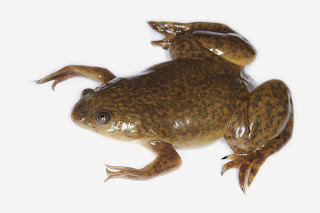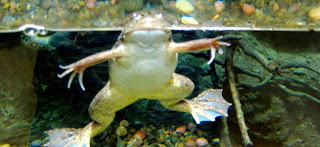Tuesday, November 18, 2014
African Clawed Frog
African Clawed Frog Classification and Evolution
The African Clawed Frog is a large species of flat Frog that is primarily found dwelling at the bottom of lakes and rivers. The African Clawed Frog is also known as the Platanna and has a number of very unique features that mean it is specially adapted to it's habitat. The African Clawed Frog is thought to have originated in South Africa, and is today found naturally across the African continent. The African Clawed Frog has also been introduced to the Americas and parts of Europe.
African Clawed Frog Anatomy and Appearance
The average adult African Clawed Frog grows to about 12 cm in length, and weighs around 200g. The African Clawed Frog is often a greenish, grey colour although other colours of the African Clawed Frog are not uncommon (such as albino). The colour of the African Clawed Frog's skin, along with it's mottled pattern, gives it more camouflage from hungry predators. They have a line of stitch-marks along either side of their bodies which act as sense organs to detect prey in the surrounding water. Their eyes and nose are located on top of the head enabling them to see and breathe but without being too visible.
African Clawed Frog Distribution and Habitat
The African Clawed Frog is most commonly found in eastern and southern Africa, along the African Rift Valley where they prefer stagnant waters to fast-flowing streams. African Clawed Frogs are bottom-dwelling animals and will only leave the safety of the water if they are forced to migrate. They inhabit warm shallow creeks and rivers during the summer and move into the flooded forests during the rainy season. Due to introduction by Humans, the African Clawed Frog can now be found in numerous freshwater habitats outside of Africa where they can be a very invasive species.
African Clawed Frog Behaviour and Lifestyle
The African Clawed Frog spends its whole life in water, except for poking its head up to the surface from time to time to breathe. The African Clawed Frog can swim at astonishing speeds sideways, backwards, forwards, up and down, and in all other directions. It is a ferocious predator and once food has been spotted, the African Clawed Frog then catches it's prey using it's claws, which shovel it into the African Clawed Frog's mouth. The African Clawed Frog has evolved very successfully as a bottom-dwelling animal, which means that it has greater protection from predators and a better choice of food.
African Clawed Frog Reproduction and Life CyclesFemale African Clawed Frogs are often nearly double the size of the males, and are able to reproduce more than once a year. After mating, the female African Clawed Frog can lay thousands of eggs at a time on an underwater object, which are held together in the water by a jelly-like substance. After hatching, the African Clawed Frog tadpoles begin their life in the water until they grow legs and are able to venture out onto the river banks if need be. The African Clawed Frog is known to have a long lifespan for small aquatic animals, and can live to around 5 to 15 years in the wild. Some adult African Clawed Frogs have been recorded to live to nearly 30 years old in captivity.
African Clawed Frog Diet and Prey
The African Clawed Frog is a carnivorous animal and an apex predator within it's underwater environment. The African Clawed Frog's main food is Water Bugs and small Fish but the African Clawed Frog is also known to eat it's own skin whenever it is shed. African Clawed Frogs also hunt other small invertebrates such as Insects, Spiders and Worms, which it scoops into it's mouth using it's clawed front feet. African Clawed Frogs in captivity have a much less varied diet which primarily consists of Worms.
African Clawed Frog Predators and Threats
Due to its small size, the African Clawed Frog has a number of natural predators within its native environment, that occur both in and out of the water. Small mammals including Rodents, Cats and Dogs, and numerous Birds and Reptiles, all prey on the African Clawed Frog, but herons are their most common threat. By living on the muddy bottoms of lakes and rivers, the African Clawed Frog can remain safely hidden for much of the time, and only it's eyes and nose appear above the water-line when it surfaces. Although not as vulnerable as many other amphibians, the African Clawed Frog is also being threatened by water pollution.
African Clawed Frog Interesting Facts and Features
The African Clawed Frog is named for their unique feet, as their hind feet are webbed but their front legs have clawed toes instead, which are used to help shovel food into their mouths. In the 1940s the African Clawed Frog became the world's first pregnancy test for Humans, which although barbaric, has led to them being found worldwide today. The African Clawed Frog has also been a popular test subject for scientific research for in general. They are known to be highly aggressive animals and particularly ferocious amphibians.
African Clawed Frog Relationship with Humans
Over the years, Humans have managed to find a number of uses for the African Clawed Frog in our day to day lives. The most notable (and probably cruellest) of these practises was the use of the African Clawed Frog females as a type of pregnancy test. The hormone produced by Human babies (passed on through the mother's urine) known as HCG, induces ovulation in the female African Clawed Frog. Humans also use them in laboratories worldwide for research and teaching. Habitat loss and water pollution caused by people nearby is also having a drastic effect on African Clawed Frog populations.
African Clawed Frog Conservation Status and Life Today
Although the African Clawed Frog has been classified as being at Least Concern from imminent extinction, population numbers have fallen in certain areas due to deteriorating water quality. Elsewhere, African Clawed Frog populations around the world have often become non-native pests to the local plants and wildlife.
Subscribe to:
Post Comments (Atom)
















No comments:
Post a Comment